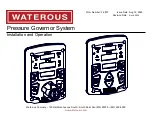
USE ONLY GENUINE REPLACEMENT PARTS
Page 14 of 21
Aq
Rev. B
Chemical water balance
The water must be balanced manually
BEFORE
the device is started up.
The following table summarizes the concentrations recommended by Hayward. Your water should be checked regularly to
maintain these concentrations and minimize surface corrosion or deterioration.
CHEMISTRY
Recommended CONCENTRATIONS
Salt
3.2 g/l
Salt (Low salt)
1.5 g/l
Free chlorine
1.0 to 3.0 ppm
pH
7.2 to 7.6
Cyanuric acid
(Stabilizer)
20 to 30 ppm max.
(Add stabilizer only if necessary)
0 ppm in indoor pool
Total alkalinity
80 to 120 ppm
Water hardness
200 to 300 ppm
Metals
0 ppm
Saturation index
-0.2 to 0.2 (preferably 0)
Saturation index
The saturation index (Si) gives us information about the calcium content and alkalinity of the water; it is a water balance indicator.
Your water is correctly balanced if the Si is 0 ± 0.2. If the Si is below -0.2, the water is corrosive and the coating on the pool walls
may be damaged. If the Si is above +0.2, stains may appear. Use the table below to determine the saturation index.
Si = pH + Ti + Ci + Ai - 12.1
°C
°F
Ti
Hardness
(Calcium)
Ci
Total
alkalinity
Ai
12
16
19
24
29
34
39
53
60
66
76
84
94
100
0.3
0.4
0.5
0.6
0.7
0.8
0.9
75
100
125
150
200
250
300
400
600
800
1.5
1.6
1.7
1.8
1.9
2.0
2.1
2.2
2.4
2.5
75
100
125
150
200
250
300
400
600
800
1.9
2.0
2.1
2.2
2.3
2.4
2.5
2.6
2.8
2.9
Use: Measure the pH of the pool water, the temperature, water hard-
ness and total alkalinity. Use the table above to determine Ti, Ci and
Ai in the formula shown above. If the Si is equal to 0.2 or more, stains
may appear. If the Si is equal to -0.2 or less, corrosion or deterioration
may occur.
{
- 0.2
0.2
0
OK
CORROSION
STAIN
•
WARNING
– Chemicals can cause internal and external burns. To avoid death, serious injury and/or damage to equipment,
wear personal protective equipment (gloves, goggles, mask, etc.) when servicing or maintaining this device. The treatment products
must be installed and/or stored in an adequately ventilated place.
















































